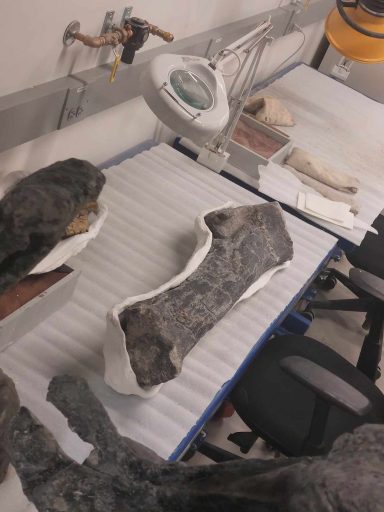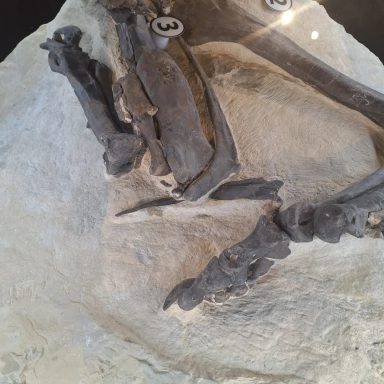The United States of America
Welcome to the world of Palaeontology in the United States...
History of Paleontology in the United States.
The history of paleontology in the United States refers to the developments and discoveries regarding fossils found within or by people from the United States of America.
Local paleontology began informally with Native Americans, who have been familiar with fossils for thousands of years. They both told myths about them and applied them to practical purposes. African slaves also contributed their knowledge; the first reasonably accurate recorded identification of vertebrate fossils in the new world was made by slaves on a South Carolina plantation who recognized the elephant affinities of mammoth molars uncovered there in 1725.
The first major fossil discovery to attract the attention of formally trained scientists were the Ice Age fossils of Kentucky's Big Bone Lick. These fossils were studied by eminent intellectuals like France's George Cuvier and local statesmen and frontiersman like Daniel Boone, Benjamin Franklin, William Henry Harrison, Thomas Jefferson, and George Washington. By the end of the 18th century possible dinosaur fossils had already been found.
By the beginning of the 19th, their fossil footprints definitely had. Later in the century as more dinosaur fossils were uncovered eminent paleontologists Edward Drinker Cope and Othniel Charles Marsh were embroiled in a bitter rivalry to collect the most fossils and name the most new prehistoric species. Early in the 20th century major finds continued, like the Ice Age mammals of the La Brea Tar Pits, the Oligocene bonebeds of South Dakota, and the Triassic bonebeds of New Mexico. Mid-to-late twentieth century discoveries in the United States triggered the Dinosaur Renaissance as the discovery of the bird-like Deinonychus overturned misguided notions of dinosaurs as plodding lizard-like animals, cemented their sophisticated physiology and relationship with birds. Other notable finds include Maiasaura, which provided early evidence for parental care in dinosaurs and "Seismosaurus" the largest known dinosaur.
My Visit's to the United States of America.
Even though I have been to muiltiple states in America the one state i visit most is Kentucky this is because my Partner lives and works in the state of Kentucky and as explained above the first major discovery of fossil's in America was at Big Bone Lick which is located in Kentucky.
In my visits to America, I have been and explored Cincinnati natural history museum, the Falls of Ohio, American Musuem of Natrual History, Children's Museum-Indianapolis, St Louis Musuem and so much more.
Relatively close to my parter is the Ohio River which the Falls of Ohio rest on meaning I have been able to go on muliple times to explore the fossils beds.

Cincinnati Natural History Museum.
The Cincinnati Museum Center is a museum complex operating out of the Cincinnati Union Terminal in the Queensgate neighborhood of Cincinnati, Ohio. It houses museums, theater, a library, and a symphonic pipe organ, as well as special traveling exhibitions.

Fall's Of Ohio State Park
Falls of the Ohio State Park is a state park in the U.S. state of Indiana. It is located on the banks of the Ohio River at Clarksville, Indiana, across from Louisville, Kentucky. The park is part of the Falls of the Ohio National Wildlife Conservation Area. The exposed fossil beds of the Jeffersonville Limestone dated from the Devonian period are the main feature of the park, attracting about 160,000 visitors annually. The Falls was the site where Lewis and Clark met for the Lewis and Clark Expedition at George Rogers Clark's cabin.

Center of Science and Industry.
COSI Columbus strives to engage, inspire, and transform lives and communities by being the best partner in science, technology, and industry learning.

The Children's Museum of Indianapolis.
The Children's Museum of Indianapolis is the world's largest children's museum. It is located at 3000 North Meridian Street, Indianapolis, Indiana in the United Northwest Area neighborhood of the city. The museum is accredited by the American Alliance of Museums

Saint louis Science Centre.
The Saint Louis Science Center, founded as a planetarium in 1963, is a collection of buildings including a science museum and planetarium in St. Louis, Missouri, on the southeastern corner of Forest Park. The Also a great experience of "Sue" The T-Rex which my partner came across and found for me.

We need your consent to load the translations
We use a third-party service to translate the website content that may collect data about your activity. Please review the details in the privacy policy and accept the service to view the translations.








































































